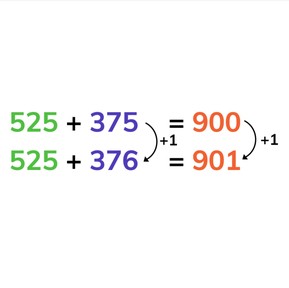



8,000 schools use Gynzy
92,000 teachers use Gynzy
1,600,000 students use Gynzy
General
Students learn to add to 1,000 using a strategy in which they either count one more or take one away.
Common core standard(s)
2.NBT.B.7
Relevance
Discuss with students that it is useful if you can add using one more or one less. If you know when to add one more, or take one away, you don't need to calculate sets of addition problems separately.
Introduction
Show a set of number sequences on the board. The students must race against the timer to fill in all the missing numbers. Then students must determine what the neighbor numbers of the given numbers are.
Development
Show the MAB-blocks on the interactive whiteboard. Say that there are 125 blocks and 75 blocks are added. Together this totals 200. Discuss the rest of the addition problems shown by the MAB blocks. Ask students if they notice anything about the addition problems. They should notice that one block is added each time. There aren't always images to count when adding with one more or one less, sometimes there are just numbers. You then have to look carefully at each addition problem. Compare the addition problems. If the first addend in the second problem is one more than the first addend in the first problem, then the answer will also be one more. Show the addition problems on the interactive whiteboard and ask students what the totals are. Ask how they determined the answer of the second addition problem, and the third. Did they calculate it again or did they just add one more each time? Tell students that when the second addend in the second problem is one more than the second addend in the first problem, the answer is also one more. Practice exercises demonstrating this.
Then show the MAB blocks on the board. Say that there are 82 and that 100 more are being added. Together the total is 182. Discuss the rest of the images and blocks. Ask students if they notice anything. They should see that each time one less is taken away. You don't always have images to count with addition problems, so what do you do with only numbers? Look carefully at the addition problems. If the first addend is one less in the second problem, than the first addend in the first problem then the total is also one less. Show problems on the interactive whiteboard demonstrating this. Ask students to solve a problem with one less. Ask them how they determined their answer. Ask them if they recalculated the entire problem or if they just took one away. Next tell students that when the second addend in the second problem is one less than the second addend in the first problem, the answer is also one less. Practice exercises in which this is demonstrated. Ask students to write their answers on a sheet of paper and to hold them up so you can check their answers.
Check that students are able to add to 1,000 with one more or one less by asking the following questions/exercises:
- What do you need to look closely at to know if you add one or take one away?
- Calculate the following addition problems: 28+600=, 28+599=
- Calculate the following addition problems: 715+185=, 714=185=,713+185=
Guided practice
Students first practice adding with one more or one less with a set of two addition problems. Then students are asked to add one more or one less with a set of three addition problems.
Closing
Discuss with students that it is important to be able to add to 1,000 with adding one more or one less, so that you can quickly solve a set of addition problems without solving each one separately. Show the addition problems on the interactive whiteboard and ask students to calculate. Ask how they solved the problems. Erase the grey boxes to reveal the answers.
Teaching tips
Students who have difficulty with adding with one more or less can make use of MAB blocks to make it more visual. Ask students to set out the amount of blocks representing an addition problem. Then give them an addition problem that is one more. Show them that they simply add one block to their existing problem shown in blocks. Repeat this with one less.
Instruction materials
MAB-blocks
The online teaching platform for interactive whiteboards and displays in schools
Save time building lessons
Manage the classroom more efficiently
Increase student engagement
Discover more!
About Gynzy
Gynzy is an online teaching platform for interactive whiteboards and displays in schools.
With a focus on elementary education, Gynzy’s Whiteboard, digital tools, and activities make it easy for teachers to save time building lessons, increase student engagement, and make classroom management more efficient.



